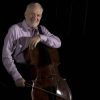- To create drama and intensity by using a faster vibrato speed.
- To create peaceful and relaxed moods by using a slower vibrato speed.
- To increase/decrease the speed of your vibrato, experiment with the following: the amount of contraction/relaxation of your bicep muscle; lightening or deepening the finger into the fingerboard; compacting the hand or allowing daylight between the fingers; slanting or squaring the hand position.
- Pushing or forcing the vibrato can lead to injury. When increasing vibrato speed, be careful not to allow more tension than necessary in your bicep muscle.
- Sinking deeper into the fingerboard can help increase vibrato speed. If the dynamic is soft but the mood dramatic, the bow will be light. Consequently, the left hand can feel deeper than the right. (This is an exception to the principle discussed in “Uniting the Hands.”)
- Define for yourself what you want to express and choose a vibrato speed to help you create that mood. A fast vibrato creates mystery, drama and tension. A slow vibrato creates peacefulness and relaxation.
- If your vibrato sounds too fast and you are having trouble slowing it down, slightly opening the hand to allow daylight between the fingers can help slow the pulsation. Squaring the hand position instead of slanting it may help slow the pulsation. Watch “Vibrato:Hand Position.”
- If your vibrato sounds too slow and you have to force to speed it up, try keeping the hand compact and the fingers together to help speed the pulsation. Slanting the hand position instead of squaring it can help speed the pulsation. Watch “Vibrato:Hand Position.”
- Only your ear and your musical judgment can tell you how wide or narrow, fast or slow to vibrate.”Attach your ear” directly to the sound of your vibrato and let the ear be attentive to the mood you want to convey. Does changing the speed help express it better? It is all too easy (and common) to slip into using one vibrato regardless of the musical context. Ultimately, music requires everything our imaginations can invent, so after the rules are learned they must also be broken.
About

Paul Katz
Paul Katz is known for his 26-year career as cellist of the internationally acclaimed Cleveland Quartet; as a world-renown teacher…
See MoreCellosophy
"Vibrato is tied to the heart; how we vary it helps us express moods, characters, and emotions. Vibrato is a defining quality of each person’s unique sound and artistry." -Paul Katz